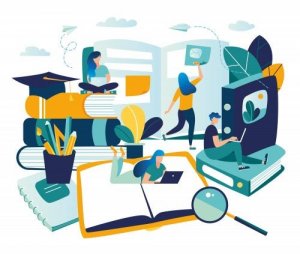The Social Mapping Technique in Education

There are various participatory techniques that students can carry out in schools, such as the innovative methodology known as social mapping. Keep reading to learn all about the social mapping technique in education.
Currently, an inclusive school model is gaining popularity among educational institutions. This model focuses on equitably serving any type of student body. This type of education also aims to encourage students to actively participate in different areas of school life. The social mapping technique helps to achieve this.
What is social mapping?
Social mapping is a technique that allows people to build integral knowledge of a place through society’s participation and commitment. Hence, we can consider it as a tool for social planning and transformation since it serves to visualize conflicts, report injustices, make improvements, etc.

According to Barragán and Amador, there are three types of social maps:
- Ecosystem-population. Its purpose is to study the territorial relations between the population and nature.
- Temporary-social. This seeks to recognize the changes that take place in certain areas with the passage of time. It helps us understand the present in order to consider possible actions in the future for social improvement.
- Thematic. It allows us to visualize specific problems in the environment that must undergo a transformation process to be solved.
Social mapping in education
Social mapping can certainly be implemented in the educational context, encouraging creativity and student participation. Children become the main protagonists of learning, while teachers assume the role of guiding and orienting the teachings.
Thus, students reflect autonomously on their own reality and represent it through the creation of social maps. This also helps teachers get relevant information about:
- The students’ opinions and visions about certain topics.
- Advantages and strengths of the educational context.
- The critical and problematic points that need a solution.
Besides that, it encourages the personal development of students and focuses on the exchange of ideas as a way of knowing and valuing other points of view.
How can they implement this technique?
To carry out the social mapping technique in education, the first thing the teachers must do is select:
- The type of problem: improving the classroom structure, upgrading the playground, denouncing areas in neglect, identifying places where bullying occurs, etc.
- The type of social map that will be created.
Likewise, teachers should also make sure they follow these steps:
- Motivate children to participate and give their ideas with absolute freedom and confidence.
- Divide the class into small groups, appointing a moderator to each group who will organize the speech lineup while encouraging participation as well.
- Assign conventions (representations, signs, drawings, graphics) for each of the elements that are represented on the social map.
- Ask students to write down the reason for what they represent on the social map. They should also try to propose a series of solutions.
- Make a critical reading of the social maps that have been completed. Subsequently, teachers must respond to the students’ demands and decide to implement viable solutions.
Therefore, with this methodology, children can express themselves and show their opinions about the school. Thus, teachers can discover where students place nice areas, dangerous places, what things they would like to change, things they wouldn’t keep, etc.

Advantages of social mapping in education
The main advantage of using social mapping in the classroom is that students can actively intervene in the transformation of the educational community. Additionally, the use of this technique also implies other advantages, such as:
- Facilitating the management of information through visual representations.
- Solving problems through proposals with creative solutions.
- Applying an innovative methodology without the need for large or expensive resources.
- Developing participation and cooperation.
In short, social mapping is especially useful for knowing the students’ thoughts regarding the educational context. Above all, the maps that the students elaborate show the information that they consider relevant.
However, it’s very important to respond to the students’ demands and put into practice the possible solutions that they propose after creating the social maps. This will make the children feel that their work and participation serve to change something in the school.
There are various participatory techniques that students can carry out in schools, such as the innovative methodology known as social mapping. Keep reading to learn all about the social mapping technique in education.
Currently, an inclusive school model is gaining popularity among educational institutions. This model focuses on equitably serving any type of student body. This type of education also aims to encourage students to actively participate in different areas of school life. The social mapping technique helps to achieve this.
What is social mapping?
Social mapping is a technique that allows people to build integral knowledge of a place through society’s participation and commitment. Hence, we can consider it as a tool for social planning and transformation since it serves to visualize conflicts, report injustices, make improvements, etc.

According to Barragán and Amador, there are three types of social maps:
- Ecosystem-population. Its purpose is to study the territorial relations between the population and nature.
- Temporary-social. This seeks to recognize the changes that take place in certain areas with the passage of time. It helps us understand the present in order to consider possible actions in the future for social improvement.
- Thematic. It allows us to visualize specific problems in the environment that must undergo a transformation process to be solved.
Social mapping in education
Social mapping can certainly be implemented in the educational context, encouraging creativity and student participation. Children become the main protagonists of learning, while teachers assume the role of guiding and orienting the teachings.
Thus, students reflect autonomously on their own reality and represent it through the creation of social maps. This also helps teachers get relevant information about:
- The students’ opinions and visions about certain topics.
- Advantages and strengths of the educational context.
- The critical and problematic points that need a solution.
Besides that, it encourages the personal development of students and focuses on the exchange of ideas as a way of knowing and valuing other points of view.
How can they implement this technique?
To carry out the social mapping technique in education, the first thing the teachers must do is select:
- The type of problem: improving the classroom structure, upgrading the playground, denouncing areas in neglect, identifying places where bullying occurs, etc.
- The type of social map that will be created.
Likewise, teachers should also make sure they follow these steps:
- Motivate children to participate and give their ideas with absolute freedom and confidence.
- Divide the class into small groups, appointing a moderator to each group who will organize the speech lineup while encouraging participation as well.
- Assign conventions (representations, signs, drawings, graphics) for each of the elements that are represented on the social map.
- Ask students to write down the reason for what they represent on the social map. They should also try to propose a series of solutions.
- Make a critical reading of the social maps that have been completed. Subsequently, teachers must respond to the students’ demands and decide to implement viable solutions.
Therefore, with this methodology, children can express themselves and show their opinions about the school. Thus, teachers can discover where students place nice areas, dangerous places, what things they would like to change, things they wouldn’t keep, etc.

Advantages of social mapping in education
The main advantage of using social mapping in the classroom is that students can actively intervene in the transformation of the educational community. Additionally, the use of this technique also implies other advantages, such as:
- Facilitating the management of information through visual representations.
- Solving problems through proposals with creative solutions.
- Applying an innovative methodology without the need for large or expensive resources.
- Developing participation and cooperation.
In short, social mapping is especially useful for knowing the students’ thoughts regarding the educational context. Above all, the maps that the students elaborate show the information that they consider relevant.
However, it’s very important to respond to the students’ demands and put into practice the possible solutions that they propose after creating the social maps. This will make the children feel that their work and participation serve to change something in the school.
All cited sources were thoroughly reviewed by our team to ensure their quality, reliability, currency, and validity. The bibliography of this article was considered reliable and of academic or scientific accuracy.
- Artíles, L., Dinorah, G., Romero, G. y Raymundo, P. (2005). La escuela más allá de sus muros: Herramientas para una comprensión transformadora del contexto. Santo Domingo: Fe y Alegría República Dominicana y Federación Internacional de Fe y Alegría.
- Barragán, D. F. y Amador, J. C. (2014). La cartografía social-pedagógica: una oportunidad para producir conocimiento y re-pensar la educación. Itinerario educativo, 28(64), 127-141.
- Herrera, J. (2008). Cartografía Social. Recuperado de: https://juanherrera.files.wordpress.com/2008/01/cartografia-social.pdf
- Valderrama, R. (s.f.) El mapeo social como herramienta educativa en el trabajo por proyectos: aprendizaje autónomo, activo e inductivo en la comunidad educativa. Universidad de Sevilla: Departamento Teoría e Historia de la Educación y Pedagogía Social.
This text is provided for informational purposes only and does not replace consultation with a professional. If in doubt, consult your specialist.








